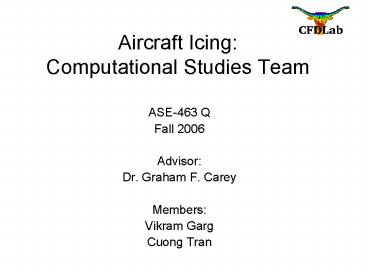Aircraft Icing: Computational Studies Team - PowerPoint PPT Presentation
1 / 19
Title:
Aircraft Icing: Computational Studies Team
Description:
Future Work. Currently working on unsteady stabilized simulations ... Stability analysis from simulation data. Speaker: Cuong Tran. Questions. Do you have any? ... – PowerPoint PPT presentation
Number of Views:70
Avg rating:3.0/5.0
Title: Aircraft Icing: Computational Studies Team
1
Aircraft Icing Computational Studies Team
- ASE-463 Q
- Fall 2006
- Advisor
- Dr. Graham F. Carey
- Members
- Vikram Garg
- Cuong Tran
2
Presentation Outline
- Background and Motivation - Cuong
- Finite Element Method - Vikram
- Meshing - Cuong
- Post-processing and Preliminary Results - Vikram
- Completed and Future Work - Cuong
3
Background
- Icing on wings rapidly frozen water droplets
accumulate on wings - Negative effects loss in lift, increase in
drag, lower stall angle, and loss of stability - Cessna wingtips subject of study in our
department
4
Motivation
- Experimental approach
- limited choice of parameters
- time-consuming
- Numerical approach
- input parameters easily modified
- data extraction is simple and robust
- fast design modifications are possible for
optimization
5
Objectives
- To model the effects of icing on the flow field
around an airfoil - Formulate and implement a Finite Element solution
of the mathematical model - Extract appropriate data from the simulations to
compute performance parameters (CL, CD, etc) - Analyze the impact of the icing on aircraft
stability (CM)
6
Finite Element Method
- Numerical method to solve flow PDEs.
- Discretize domain meshing
- Introduce approximations to variables
- Solve a (or a sequence of) linear system(s) to
get approximate solution
7
Governing Equations
- Basic equations governing incompressible, viscous
(Newtonian) fluid flow - Re Reynolds number - different flow regimes
- 0 lt Re lt 10 Stokes flow
- 10 lt Re lt 1000 Laminar flow
- 1000 lt Re ... Turbulent
flow
8
Solution Methodology
- First get a mesh (Unstructured, Triangles)
Matlab TRIANGLE - Formulation Weak form, add numerical
stabilization term - Assemble and solve linear system (or seq.) to get
- Libmesh - Prelim. Post-process P distribution, vel.
profiles
9
Airfoil Specs
- Swept GLC-305 airfoil
- 18.72 inch chord length
- Chord length used for non-dimensionalization (Re,
L, etc.)
10
Meshing
- Wrote Matlab code to extract x y coordinates of
each airfoil - TRIANGLE uses nodal points along airfoil
bounding box to create a mesh - Libmesh uses triangular elements
- Linear (with 3 nodal pts) for pressure
- Quadratic (with 6 nodal pts) for velocity
11
Meshing Results
TRIANGLE meshing output
Clean Airfoil
Zoomed in on Ice Horn
The fine, detailed meshing near the surface of
each airfoil enables accurate data acquisition.
12
Pressure Distribution
- Re 100, steady state
- Distortion at leading edge due to ice, flow
attached in rear for both cases
13
Pressure Distribution
- Re 1000, s-s
- Similar to Re 100
14
Velocity Profile
Re 1000, boundary layer growth, s-s
15
Unsteady Flow
- Re 100, pressure disturbance due to ice horn
- Ice effects significant, but again localized
16
Separation
- Icing small separation bubble, Re 100
17
Completed Work
- Numerical simulation meshing, solving
- Finite Element formulation of NS equations
- High Reynolds No. - with numerical stabilization
- Code Validation Backwards Facing Step
18
Future Work
- Currently working on unsteady stabilized
simulations for higher Re numbers - Write routines for CL, CD, CM
- Stability analysis from simulation data
19
Questions
- Do you have any?































